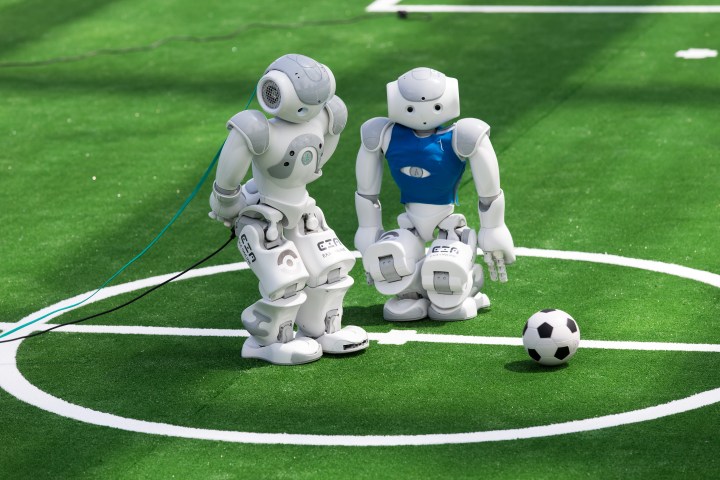
“The ultimate goal of Robocup is to develop humanoid soccer-playing robots that can beat the FIFA world champion team,” General Chair of Robocup 2016, Gerhard Kraetzschmar, tells Digital Trends. “We hope to reach that goal by 2050.”
Since the Robocup’s creation in 1996, the robots’ abilities have significantly improved but they’re still hardly cut out for the pee-wee league. The humanoid robots’ movements tend to be clunky and sporadic. They’ll make the occasional impressive kick or save, but they’re nothing compared to what you’d watch in this year’s UEFA Euro tournament. “They are far from being able to execute a shot like Xherdan Shaquiri of the Swiss national team,” Kraetzschmar says. “That was the most beautiful goal so far in this championship.”
The reason for these difficulties boil down to three handicaps: physical agility, stamina, and perception.
Developing physical agility in robots requires inventing “radically new actuation concepts,” according to Kraetzschmar. “Artificial muscles have been a somewhat eclectic research topic for well over 20 years, but most of the concepts developed so far are not ready for use in our robots.”
As far as stamina is concerned, current batteries are heavy and barely keep the robots active for half the match. Where professional teams stretch and review strategies during halftime, the robot squads have battery swaps.
Lastly, programming perception into a robot is a hurdle for the engineers behind the autonomous machines. “Allowing the robots to behave predictably especially while encountering unforeseen situations is critical,” Steve McGill, captain of the UPennalizers (Robocup reigning champions) tells Digital Trends. “When developing robotic systems, it is important to field test a tremendous amount of conditions. In soccer, this means evaluating, for instance, tricky ball positions along the edges of the field or nearby obstacles that could topple the robot.”
“Just as in real soccer, a good robot soccer team is very good in the fundamentals — seeing the ball and field well, making fast, good decisions, and moving the ball quickly and effectively,” UPennalizer coach Daniel Lee adds. “We’ve had a lot of experience making smarter robots over the years to excel at those skills.”
The UPennalizers have decided to hang up their cleats this year after five consecutive championship wins. Instead, they’ll demonstrate at the Robocup Rescue arena, where robot teams are challenged to respond to and navigate simulated disaster scenarios such as earthquakes and tsunamis. Here the robots will be exposed to the elements outdoors to challenge their sensors and movement. Rather than training machines to defeat humans, the goal of the rescue arena is to develop machines that save us and keep us safe.
Robocup’s 2050 goal may seem far fetched but, as McGill puts it, “You have to dare to dream.”
Kraetzschmar meanwhile gives a more thorough answer. “Like anyone else, I think that this idea is really crazy, and that it could probably not be achieved,” he says. “But I am also a researcher working on solving this challenge and, if I look at the progress made in the past 20 years, I must say that it is absolutely not impossible that we may actually achieve it.
“Yes, some major breakthroughs are still necessary, but if there is a community likely to achieve these breakthroughs, it is the RoboCup community.”
Good luck to all the teams and may the best bots win!



